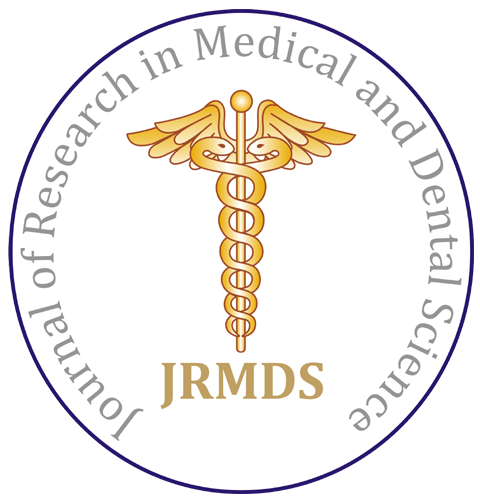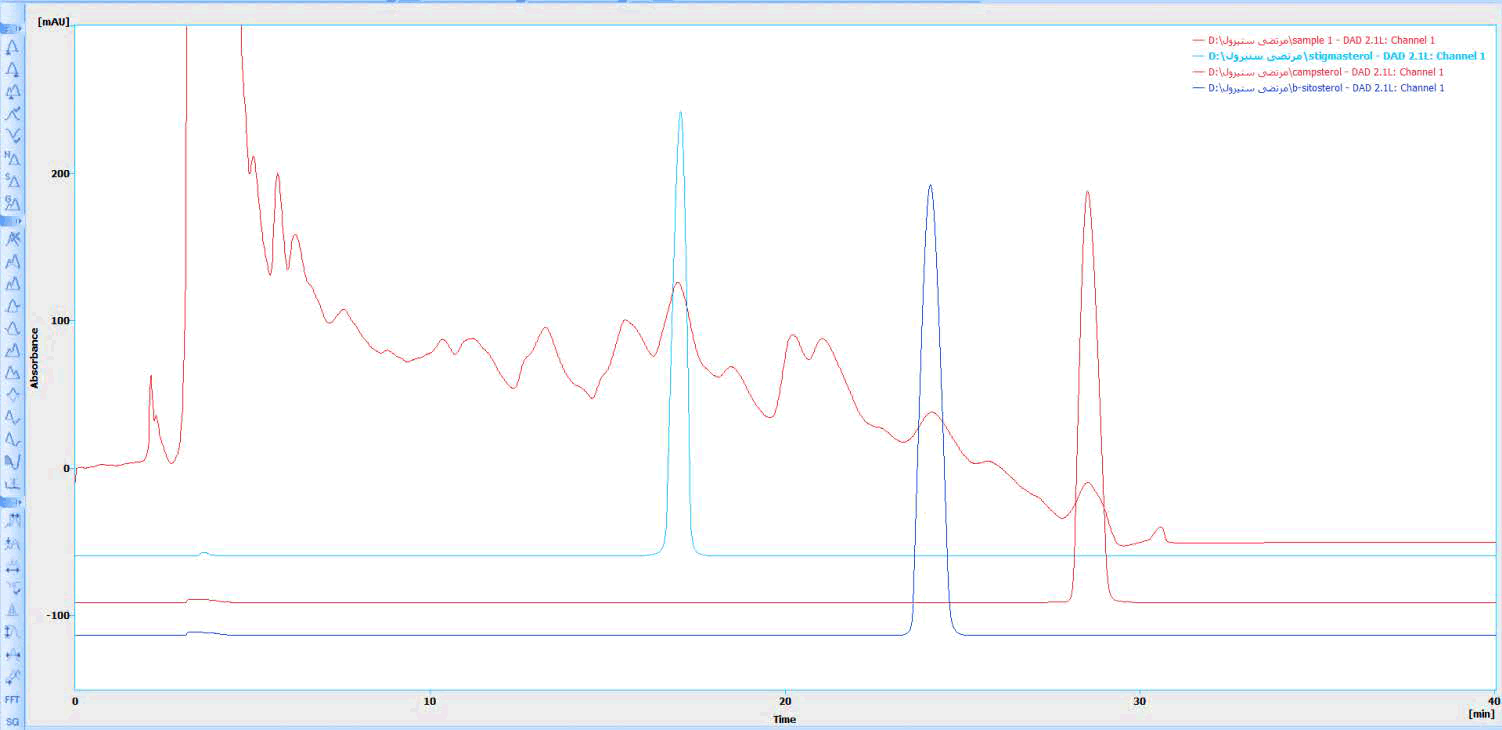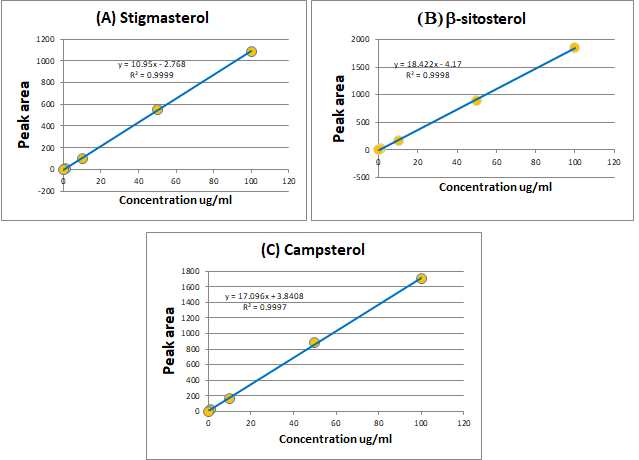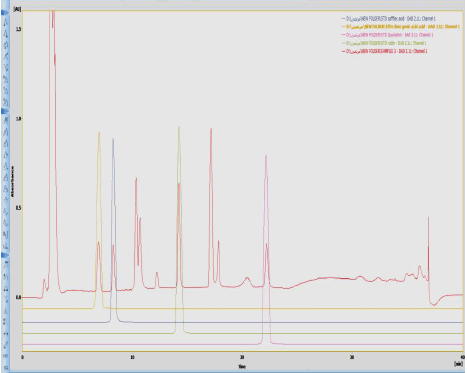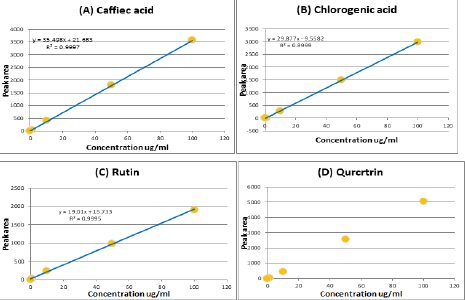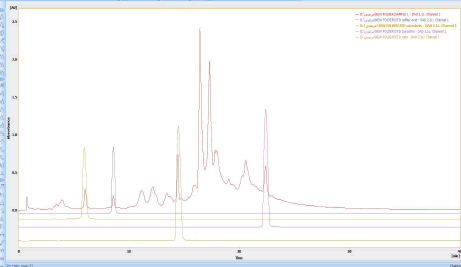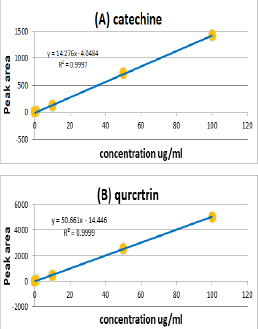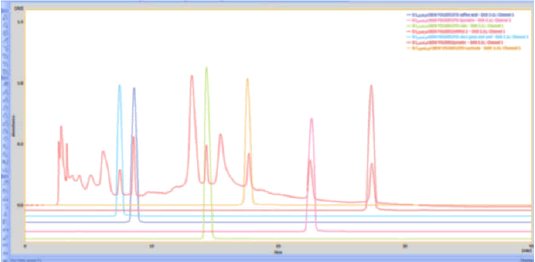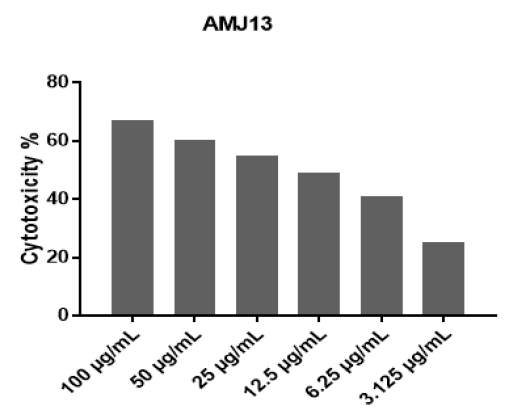Research Article - (2025) Volume 13, Issue 1
Polyphenolic Compounds from Lactuca serriola Aerial Parts Growing in Iraq Exhibit Anticancer Properties and Concurrent HPLC-DAD Profiling
Murtadha Saleh Hussien1 and Ayad A Al-Hamashi2*
*Correspondence: Ayad A Al-Hamashi, Department of Pharmaceutical Chemistry, College of Pharmacy, University of Baghdad, Baghdad, Iraq, Email:
Abstract
The present study was carried out to investigate the phytochemical constituent of Iraqi Lactuca serriola aerial part and to evaluate the cytotoxic effect of plant. The aerial part of Lactuca serriola were collected, dried, pulverized, and extracted with methanol using Soxhlet. The extract was concentrated, and the resulting residue was successively partitioned with solvent have different polarity including hexane, chloroform, ethyl acetate, N-butanol. The result fractions were subjected to general phytochemical screening, thin layer chromatography and High Performance Liquid Chromatography (HPLC) analysis. The results indicated the presence of phytosterol in the hexane fractions and the phenolic substances in the other fractions. Quercetin, chlorogenic acid, caffeic acid, lactucin, rutin, and quercetrin are six active constituents that were identified from Iraqi Lactuca serriola's n-butanol fraction. In vitro testing for cytotoxicity against AMJ13 breast cancer cell line revealed that the aerial parts of the plant Lactuca serriola of the Asteraceae family contained an ethyl acetate extract that has a promising cytotoxicity against breast cancer. According to the research, Lactuca has 67.3% cytotoxic activity at the tested dose of 100 mg/mL against the AMJ13-inhibited cancer cell.
Keywords
HPLC, Lactuca serriola, Phenolic compound, Anticancer activity, Cytotoxicity
Introduction
Plants are a known source of medications for the vast majority of the world's population for thousands of years [1]. The use of natural products as a sickness relief is traced back to early civilization of China, India, and the Near East [2,3]. The traditional medicines are used by more than 80% of the world's population for primary health care. The natural products medical value is due to the presence of chemical compounds that have a specific pharmacological effect on the human body. Flavonoids, tannins, alkaloids, and phenolic compounds are the most important bioactive chemicals [4]. Linking folkloric uses of natural products to the modern research operations provides a novel technique that significantly increases the rate of drug discovery and development [5].
Asteraceae species involve many phytochemical components such as phytosterol, essential oils, lignans, saponins, polyphenolic compounds, phenolic acids, sterols, and polysaccharides, that have medicinal effects [6]. Lactuca seriolla is a wild plant that belong to Asteraceae family [7]. Lactuca seriolla Linn, a member of the Astereceae family, is a type of traditional medicine plants. Prickly lettuce, wild lettuce, Jagged lettuce, Kahu, and Khas are common names used in Iraq, Lactuca serriola grows in dry conditions in the northern hemisphere and has a milky sap that oozes freely from wounds. When this comes into touch with air, it hardens and dries. The sap contains "Lactucarium," which has antispasmodic, digestive, diuretic, hypnotic, tranquilizer, and sedative properties [8]. The efficacy of either crude extracts rich in phenolic compounds or fractions comprising a variety of phenolic compounds to suppress malignancies in vitro and in vivo has been investigated in numerous research. For instance, it has been reported that the herbal plant Pandanus amaryllifolius, which is native to Malaysia, contains extracts of gallic, cinnamic, and ferulic acids, inhibits breast cancer cell lines in vitro [9].
Materials and Methods
Collection of plant materials
The Lactuca serriola plant materials (aerial part) were gathered at AL-Diwaniyah city, 180 km South of Baghdad, between September and November 2021. The plant was identified, validated, and authenticated at the department of biology, college of science, university of Baghdad. The plant was cleaned, allowed to dry in the shade at room temperature, and then ground up using an electrical miller, and weighed [10].
Extraction (Soxhlet)
A thimble was used to package the 100 g of dried plant material (Aerial portion). A round flask containing one liter of 85% ethanol was then filled, and the thimble was then placed in a Soxhlet extractor. The sample was extracted completely to exhaustion for 22 hours. The alcoholic extract was evaporated under decreased pressure, condensed to roughly 13 g, and then combined with 250 ml of distilled water to create a crude fraction [11].
Fractionation of extract
The crude fraction (13 g) was partitioned with solvents such as hexane, chloroform, ethyl acetate and n-butanol (3 × 100 ml) for each fraction. The first three fractions dried over anhydrous sodium sulfate with except nbutanol fraction. The dried fractions were weighted and assigned for further analysis [12].
HPLC fractionation
HPLC fractionation of hexane fraction (F1): The hexane fraction components were separated utilizing HPLC system of Knauer Germany. The active components were compared to standard materials through UV/Vis absorption analysis. The retention time for the sample and standard were identified. The integrated peak area was used to assess the sample quantity, and the calibration curve content was derived by plotting the sample peak area against the concentration of the appropriate standard sample. The C18 HPLC column (250 × 4.6) 5 m particles from the USA's water corporation was used to achieve the separation.
The mobile phase used for phytosterol detection was MeOH and acetonitrile of 30:70, and the solvent system gradient was gradually increased to 0:100 and the elution sustained for 10 minutes, followed by 30:70 for 15 minutes in a flow rate of 1 ml/min. The wavelength of 210 nm was used for UV detection [13].
HPLC fractionation of phenolic compound for chloroform F2, ethyl acetate F3, and n-butanol fraction F4
• Mobile phase gradient: The mobile phase contains 1% aq. acetic acid solution (solvent A) and acetonitrile (solvent B) a gradient elution was performed by varying the proportion of solvent B to solvent A. The gradient elution was changed from 10% to 40% B in a linear fashion for duration of 28 min, from 40 to 60% B in 39 min, from 60 to 90% B in 50 min. The mobile phase composition back to initial condition (solvent B: solvent A: 10: 90) in 55 min and allowed to run for another 10 min, before the injection of another sample.
• Column: Knauer/Germany LC C18 (250 mm × 4.6 mm, 5 μm particle size).
• Samples: F2, F3, F4
• Standards: Caffiec acid, rutin, quecetin, lactucin, quercetin, quercitrin, chlorogenic acid and catechine by using four concentrations (10, 20, 30, 40 μg/ml) for each one.
• Flow rate: 0.7 ml/min
• Injection volume: 20 μL
• Injection concentration: 1 mg/ml
• Detection: HPLC chromatograms were detected using a photo diode array UV detector at three different wavelengths (272, 280 and 310 nm). The detection of each compound was performed by matching retention time and absorbance spectrum of the standards the concentration was calculated by serial concentrations of external standard materials to build calibration curve between concentration and its equivalent peak area [14].
Cytotoxic assay procedures
Human tumor cell lines: Ahmed Murtada Jabria 2013 (AMJ13) breast cancer cell line has been established from an Iraqi breast cancer patient. AMJ13 was established from the primary tumor of a 70-year-old Iraqi woman with a histological diagnosis of infiltrating ductal carcinoma (Tables 1 and 2) [15].
| No. | Items | Company | Country |
|---|---|---|---|
| 1 | Trypsin/EDTA | Capricorn | Germany |
| 2 | DMSO | Santacruz Biotechnology | USA |
| 3 | RPMI 1640 | Capricorn | Germany |
| 4 | MTT stain | Bio-World | USA |
| 5 | Fetal bovine serum | Capricorn | Germany |
Table 1: Chemicals and reagents.
| No. | Item | Company | Country |
|---|---|---|---|
| 1 | Incubator | Cypress Diagnostics | Belgium |
| 2 | Microtiter reader | Gennex Lab | USA |
| 3 | Laminar flow hood | K and K Scientific Supplier | Korea |
| 4 | Micropipette | Cypress Diagnostics | Belgium |
| 5 | Cell culture plates | Santa Cruz Biotechnology | USA |
Table 2: Instruments.
Maintenance of cell cultures: The cell line was maintained in RPMI supplemented with 10% fetal bovine, 100 units/mL penicillin, and 100 μg/mL streptomycin. Cells were passaged using Trypsin-EDTA reseeded at 50% confluence twice a week, and incubated at 37°C [16].
Cytotoxicity assays: On 96-well plates, the MTT cell viability experiment was performed to detect the cytotoxic effect [17]. 104 cells per well were used to seed the cell lines. Cells were treated with the test substance after 24 hours or when a confluent monolayer was formed (ethyl acetate fraction). After 72 hours of treatment, cell viability was assessed by removing the medium, adding 28 L of an MTT solution containing 2 mg/mL, and incubating the cells for 1.5 hours at 37°C. The residual crystals in the wells were solubilized after the MTT solution was removed by adding DMSO, which was then incubated for 15 minutes at 37°C while being shaken [18]. The assay was carried out in triplicate, and the absorbency was measured on a microplate reader at 492 nm [19]. The obtained data were statically analyzed using an unpaired t-test with GraphPad Prism 6. The values were presented as the mean ± SD of triplicate measurements [20].
Results and Discussion
HPLC analysis
HPLC fractionation of hexane fraction (F1): The analytical HPLC was conducted for (F1) to identify the existence of phytosterol in Iraqi Lactuca srriola aerial part of plant. The result confirmed the presence of L1, L2 and H1 in Iraqi lactuca serrila aerial prat. Each compound was identified in the sample (F1) by its retention time and UV/Vis spectrum matching with its respected standard material (Figure 1).
Figure 1: HPLC analysis for hexane fraction of Lactuca serriola with stigma sterol, campsterol and β- sitosterol where red chromatogram=hexane fraction (sample), blue chromatogram=stigma sterol standard and purple chromatogram=β-sitosterol standard, brown chromatogram=campesterol standard.
For quantitative analysis, the calibration curve was plotted using Area Under the Curve (AUC) versus four concentration levels of stigmasterol campsterol and β- sitosterol standards from which the concentration of the proposed stigmasterol, β-sitosterol (L1and L2) and campsterol in the hexane fraction was calculated applying straight line equation, as illustrated in Figure 2. The calculated concentration of proposed stigmasterol and β- sitosterol (L1 and L2) in the Iraqi Lactuca serriola was revealed in Table 3.
Figure 2: The calibration curve of (A) stigmasterol, (B) β-sitosterol, and (C) campsterol.
| Samples | Peak area | µg/ml of fraction | µg/mg plant material |
|---|---|---|---|
| Stigmasterol | 163.299 | 4.55 | 91.11 |
| β-sitosterol | 268.028 | 4.06 | 81.29 |
| Campsterol | 83.754 | 1.31 | 26.27 |
Table 3: The concentration of the proposed stigmasterol and β-sitosterol (L1 and L2) from the hexane fraction of the plant.
HPLC fractionation of chloroform fraction (F2): Analytical HPLC was conducted for (F2) to identify the existence of new proposed phytoconstituents in Iraqi Lactuca serriola aerial part. The result confirmed the presence phenolic compound including caffiec acid, chlorogenic acid, quercitrinm and rutin. Each compound was identified in the sample (F2) by its retention time and UV/Vis spectrum matching with its respected standard material (caffiec acid, chlorogenic acid, rutin, and quercitrin standard). The retention time peaks chlorogenic acid, caffiec acid, rutin, and quercitrin respectively, also appeared in the chloroform fraction of lactuca serriola arial part (Figure 3).
Figure 3: HPLC analysis for chloroform fraction of Lactuca serriola with caffiec acid, chlorogenic acid, rutin, and quercitrin standard where chromatogram (--)= chloroform fraction (sample), (--) chromatogram=caffiec acid standard, chromatogram (--)=chlorogenic acid standard, chromatogram (--)=rutin standard and chromatogram (---)=quercitrin standard.
For quantitative analysis, the calibration curve was plotted using Area Under the Curve (AUC) versus four concentration levels of caffiec acid, chlorogenic acid, rutin, and quercitrin standards from which the concentration of the proposed caffiec acid, chlorogenic acid, rutin, and quercitrin in the chloroform fraction was calculated applying straight line equation, as illustrated in Figure 4.
Figure 4: The calibration curve of (A) Caffiec acid, (B) Chlorogenic acid, (C) Rutin, and (D) Quercitrin.
HPLC fractionation of ethyl acetate fraction (F3): For further ensuring the existence of observed components in the ethyl acetate fraction (F3), analytical HPLC was conducted for aerial ethyl acetate fraction (F3) of Iraqi Lactuca serriola obtained by hot method. The result confirmed the presence phenolic compound including caffiec acid, rutin, quercetin, and catechine. Each compound was identified in the sample (F3) by its retention time and UV/Vis spectrum matching with its respected standard material of caffiec acid, chatechine, rutin, and quercetin standard (Figure 5).
Figure 5: HPLC analysis for ethyl acetate fraction (--) of Lactuca serriola with caffiec (--) acid, catechine (---), rutin (---) and quercitrin (---) standards.
For quantitative analysis, the calibration curve was plotted using Area Under the Curve (AUC) versus four concentration levels of caffiec acid, catechine, rutin and quercetin standards from which the concentration of the proposed caffiec acid, catechine, rutin, and quercitrin in the ethyl acetate fraction was calculated applying straight line equation, as illustrated in Figure 6. The calculatedconcentration of proposed catechine and quercetrin in the Iraqi Lactuca serriola was revealed in Table 4.
| Samples | Peak area | µg/ml of fraction | µg/mg plant material |
|---|---|---|---|
| Quercetrin | 76.046 | 1.344165 | 0.887149 |
| Catechine | 275.249 | 17.31588 | 11.42848 |
Table 4: The concentration of the proposed quercetin and catechine from the ethyl acetate fraction of the plant.
Figure 6: The calibration curve of (A) catechine and (B) quercetin.
HPLC fractionation of n-butanol fraction (F4): Analytical HPLC was conducted for aerial n-butanol fraction (F4) of Iraqi Lactuca serriola that obtained by hot method. The result confirmed the presence phenolic compound including caffiec acid, rutin, quercetin, quercetin, quercitrin, chlorogenic acid, and sesquterpine lacton (lactucin). Each compound was identified in the sample (F3) by its retention time and UV/Vis spectrum matching with its respected standard material including caffiec acid, rutin, quercetin, lactucin, quercetin, quercitrin, chlorogenic acid. Figure 7 revealed that the retention time peaks chlorogenic acid, caffiec acid, rutin, lactucin, quercitrin, and quercetin respectively (Table 5).
Figure 7: HPLC analysis for n-butanol fraction (F4) (--) of Lactuca serriola with chlorogenic acid (---), caffiec (--) acid, rutin (---), lactucin (---) quercitrin (---) and Quercetin (---) standards.
| Name of standard | Peak Ret. Time for std. | Ret. Time at F4 |
|---|---|---|
| Chlorogenic acid | 7.3 | 7.4 |
| Caffiec acid | 8.7 | 8.5 |
| Rutin | 14.5 | 14.3 |
| Lactucin | 17.1 | 17.3 |
| Quercitrin | 22.3 | 22.4 |
| Quercetin | 27.6 | 27.8 |
Table 5: The retention time for standards and F4 peak.
The cytotoxic activity: According to the HPLC analysis, the ethyl acetate fraction (F2) contains phenolic compounds like caffeic acid, catechine, rutin, and quercetin. Prior research has shown that dietary phenols' positive impacts on health are caused by their capacity to display antioxidant, anti-inflammatory, and anticlastogenic actions [21]. These phenolic compounds have acceptable in vitro cytotoxic effect on AMJ13 cell lines (Figure 8).
Figure 8: Cytotoxic activity of ethyl acetate fraction extract of Lactuca serriola different concentration against cultured AMJ13 cell line in vitro.
Conclusion
A decent phytochemical study for the Iraqi Lactuca serriola was carried out. This study indicated that the aerial section of Lactuca serriola had a greater quantity of polyphenolic chemicals. It also showed a promising preliminary anticancer activity due to the presence of polyphenolic compounds. Lactuca serriola aerial component extracts have enough polyphenolic chemicals to be taken into consideration as a potential source for anticancer supplements. Therefore, Lactuca serriola aerial portion can be viewed as a product with potential use in the food and pharmaceutical industries, which may help the general public in terms of both economic and social advantages.
References
- Leena T, Jaindra NT. Role of biotechnology in medicinal plants. Trop J Pharm Res 2003; 2:243-253.
- Salau AO, OM Odeleye. Antimicrobial activity of Mucuna pruriens on selected Bacteria. African J Biotechnol 2007; 6:2091-209.
- Gutmann L, Billot-Klein D, Williamson R, et al. Mutation of Salmonella paratyphi a conferring cross-resistance to several groups of antibiotics by decreased permeability and loss of invasiveness. Antimicrob Agents Chemother 1988; 32:195-201.
[Crossref] [Google Scholar] [PubMed]
- Al-Mussawi AA. Screening for Antibacterial Activity of Twenty Two Iraqi Wild plants. Basrah J Sci 2014; 32:101-111.
- Chakravarty HL. Plant wealth of Iraq, Baghdad Botany Directorate, Ministry of Agriculture and Agrarian, Republic of Iraq.1st edition 1976; 11-27.
- Edeoga HO, Okwu DE, Mbaebie BO. Phytochemical constituents of some Nigerian medicinal plants. African J Biotechnol 1984; 4:685-688.
- Hussien MS, Al-Hamashi AA. Phytosterol Profile in Iraqi Lactuca serriola after Purification and Isolation by Combiflash and HPLC. Iraqi J Pharm Sci 2022; 31:54-61.
- Girish HV, Satish S. Antibacterial Activity of Important Medicinal Plants on Human Pathogenic Bacteria-a Comparative Analysis. World Appl Sci J 2008; 5:267-271.
- Ghasemzadeh A, Jaafar HZ. Profiling of phenolic compounds and their antioxidant and anticancer activities in pandan (Pandanus amaryllifolius Roxb.) extracts from different locations of Malaysia. BMC Complement Altern Med 2013; 13:341.
[Crossref] [Google Scholar] [PubMed]
- Li Q, Xing B. A Phytosterol-Enriched Spread Improves Lipid Profile and Insulin Resistance of Women with Gestational Diabetes Mellitus: A Randomized, Placebo-Controlleed Double-Blind Clinical Trial. Diabetes Technol Ther 2016; 18:499-504.
[Crossref] [Google Scholar] [PubMed]
- Guo XX, Zeng Z, Qian YZ, et al. Wheat Flour, Enriched with γ-Oryzanol, Phytosterol, and Ferulic Acid, Alleviates Lipid and Glucose Metabolism in High-Fat-Fructose-Fed Rats. Nutrients 2019; 11:1697.
[Crossref] [Google Scholar] [PubMed]
- Zhang ZL, Luo ZL, Shi HW, et al. Research Advance of Functional Plant Pharmaceutical Cycloartenol about Pharmacological and Physiological Activity. China J Chinese Materia Medica 2017; 42:433–437.
[Crossref] [Google Scholar] [PubMed]
- Mamtta S, Jyoti S. Phytochemical screening of Acourus calamus and Lantana camara. Int Res J Pharm 2012; 3:324-326.
- Seal T. Quantitative HPLC analysis of phenolic acids, flavonoids and ascorbic acid in four different solvent extracts of two wild edible leaves, Sonchus arvensis and Oenanthe linearis of North-Eastern region in India. J Appl Pharmaceutical Sci 2016; 6:157-166.
- Al-Shammari AM, Alshami MA, Umran MA, et al. Establishment and characterization of a receptor-negative, hormone-nonresponsive breast cancer cell line from an Iraqi patient. Breast Cancer: Targets Ther 2015; 7:223-230.
[Crossref] [Google Scholar] [PubMed]
- Adil BH, Al-Shammari AM, Murbat HH. Breast cancer treatment using cold atmospheric plasma generated by the FE-DBD scheme. Clin Plasma Med 2020; 19-20.
- Abdullah SA, Al-Shammari AM, Lateef SA. Attenuated measles vaccine strain have potent oncolytic activity against Iraqi patient derived breast cancer cell line. Saudi J Biol Sci 2020; 27:865-872.
[Crossref] [Google Scholar] [PubMed]
- Al-Shammari AM, Jalill RDA, Hussein MF. Combined therapy of oncolytic Newcastle disease virus and rhizomes extract of Rheum ribes enhances cancer virotherapy in vitro and in vivo. Mol Biol Rep 2020; 47:1691-702.
[Crossref] [Google Scholar] [PubMed]
- Mohammed MS, Al-Taee MF, Al-Shammari AM. Caspase dependent and independent anti-hematological malignancy activity of AMHA1 attenuated newcastle disease virus. Int J Mol Cell Med 2019; 8:211-222.
[Crossref] [Google Scholar] [PubMed]
- Al-Ziaydi AG, Al-Shammari AM, Hamzah MI, et al. Newcastle disease virus suppress glycolysis pathway and induce breast cancer cells death. Virusdisease 2020; 31:341-348.
[Crossref] [Google Scholar] [PubMed]
- Lambert JD, Hong J, Yang GY, et al. Inhibition of carcinogenesis by polyphenols: evidence from laboratory investigations. Am J Clin Nutr 2005; 81:284S–291S.
[Crossref] [Google Scholar] [PubMed]
Author Info
Murtadha Saleh Hussien1 and Ayad A Al-Hamashi2*
1Department of Pharmacognosy and Medicinal Plants, College of Pharmacy, University of Baghdad, Baghdad, Iraq2Department of Pharmaceutical Chemistry, College of Pharmacy, University of Baghdad, Baghdad, Iraq
Citation: Murtadha Saleh Hussien, Ayad A Al-Hamashi, Polyphenolic Compounds from Lactuca serriola Aerial Parts Growing in Iraq Exhibit Anticancer Properties and Concurrent HPLC-DAD profiling, J Res Med Dent Sci, 2024, 12 (10): 012-018.
Received: 14-Jun-2023, Manuscript No. JRMDS-23-107121; , Pre QC No. JRMDS-23-107121 (PQ); Editor assigned: 16-Jun-2023, Pre QC No. JRMDS-23-107121 (PQ); Reviewed: 30-Jun-2023, QC No. JRMDS-23-107121; Revised: 17-Oct-2024, Manuscript No. JRMDS-23-107121 (R); Published: 24-Oct-2024
